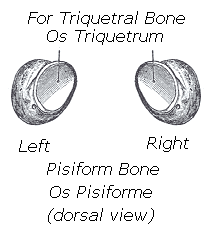Pisiform bone: Difference between revisions
imported>Aleksander Stos m (→See also: health sci category) |
imported>Caesar Schinas m (Bot: Update image code) |
||
| (2 intermediate revisions by 2 users not shown) | |||
| Line 1: | Line 1: | ||
{{subpages}} | |||
{|width=250px style="clear:all; padding: 0.5em; float:right; margin-left:15px; border: 1px solid #AAA" | {|width=250px style="clear:all; padding: 0.5em; float:right; margin-left:15px; border: 1px solid #AAA" | ||
|style="background:#C2C3FF; border:1px solid #88A" | | |style="background:#C2C3FF; border:1px solid #88A" | | ||
| Line 16: | Line 18: | ||
==Function== | ==Function== | ||
{{Image|Os_pisiforme.GIF|left|300px|pisiform}} | |||
The pisiform bone is usually classified as a [[sesamoid]] bone, although it is atypical in having a facet for articulation with another bone and not being wholly embedded within just one tendon. Sesamoid bones are typically found in places where a tendon passes over a joint, like in the hand, the knee, or the foot. They act to protect the tendon and to increase its mechanical effect. The sesamoid bone acts to hold the tendon a bit | The pisiform bone is usually classified as a [[sesamoid]] bone, although it is atypical in having a facet for articulation with another bone and not being wholly embedded within just one tendon. Sesamoid bones are typically found in places where a tendon passes over a joint, like in the hand, the knee, or the foot. They act to protect the tendon and to increase its mechanical effect. The sesamoid bone acts to hold the tendon a bit farther away from the middle of the joint, which increases its leverage. Sesamoid bones also prevent a tendon from flattening against the joint under tension and hence maintain a more consistent leverage throughout the range of possible loads. | ||
The pisiform bone may provide mechanical stability to the ulnar column of the wrist by preventing triquetral subluxation. So one might assume that surgical excision of the pisiform would cause loss of function to the wrist. However, patients, who have undergone pisiformectomy for pisotriquetral joint dysfunction, experience no significant differences in grip strength, wrist movement, static strength or dynamic power in the long run. Around 75% of patients experience complete relief of symptoms, while the rest continue to have mild discomfort. | The pisiform bone may provide mechanical stability to the ulnar column of the wrist by preventing triquetral subluxation. So one might assume that surgical excision of the pisiform would cause loss of function to the wrist. However, patients, who have undergone pisiformectomy for pisotriquetral joint dysfunction, experience no significant differences in grip strength, wrist movement, static strength or dynamic power in the long run. Around 75% of patients experience complete relief of symptoms, while the rest continue to have mild discomfort. | ||
| Line 27: | Line 29: | ||
==See also== | ==See also== | ||
* ''parent article'' - [[wrist]] or [[carpus]] | * ''parent article'' - [[wrist]] or [[carpus]] | ||
Revision as of 11:46, 11 June 2009
|
Etymology The pisiform bone, Latin os pisiforme, has also been sometimes referred to as the lentiform bone. The word pisiform comes from the Latin pīsum meaning "pea", while the word lentiform comes form the word lentil. |
The pisiform bone (os pisiforme) can be distinguished by its small size, and having a single articular facet. It is pea-shaped and is situated anteriorly to the other bones of the wrist. Its dorsal surface presents a smooth oval facet, for articulation with the triquetral bone. This facet approaches the superior, but not the inferior border of the bone. The palmar (volar) surface is rounded and rough, giving attachment to the transverse carpal ligament, and to the flexor carpi ulnaris and abductor digiti quinti. The lateral and medial surfaces are also rough, the former being concave, the latter usually convex.
Articulation: the pisiform bone articulates only with one other bone, the triquetral. The joint is called the piso-triquetral (PT) joint.
Function
The pisiform bone is usually classified as a sesamoid bone, although it is atypical in having a facet for articulation with another bone and not being wholly embedded within just one tendon. Sesamoid bones are typically found in places where a tendon passes over a joint, like in the hand, the knee, or the foot. They act to protect the tendon and to increase its mechanical effect. The sesamoid bone acts to hold the tendon a bit farther away from the middle of the joint, which increases its leverage. Sesamoid bones also prevent a tendon from flattening against the joint under tension and hence maintain a more consistent leverage throughout the range of possible loads. The pisiform bone may provide mechanical stability to the ulnar column of the wrist by preventing triquetral subluxation. So one might assume that surgical excision of the pisiform would cause loss of function to the wrist. However, patients, who have undergone pisiformectomy for pisotriquetral joint dysfunction, experience no significant differences in grip strength, wrist movement, static strength or dynamic power in the long run. Around 75% of patients experience complete relief of symptoms, while the rest continue to have mild discomfort.
Syndromes
Racquet player's pisiform:
This is an injury to the wrist involving a chondromalacia (literally "soft cartilage"), or roughening of the articular cartilage, between the pisiform and triquetral bones (the piso-triquetral joint). It is thought to be due to repeated torsional stresses on the piso-triquetral joint by sharp and powerful supination-pronation movements performed by racquet players, especially squash and badminton players; and sometimes golfers, who use a lot of wrist action. Tennis players are less prone as they tend to make strokes using the shoulder.
